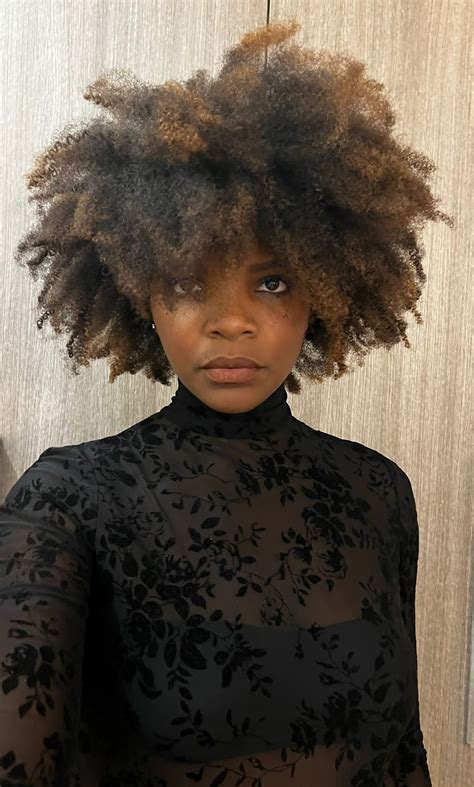Afro curly hair, an iconic representation of African heritage, is a captivating tapestry of coils, curls, and kinks. Embracing its uniqueness and understanding its specific needs are essential for showcasing its intrinsic beauty and fostering healthy hair growth.

Understanding Afro Curly Hair: A Journey into Texture
The texture of Afro curly hair is determined by the shape of its hair follicles. According to the André Walker Hair Typing System, there are four main texture categories:
- Type 4A: Coily hair with a tightly coiled “S” shape.
- Type 4B: Zigzag hair with a sharp angular pattern.
- Type 4C: Coily hair with a tightly packed, fine texture.
The Science Behind Afro Curly Hair
The distinctive characteristics of Afro curly hair are rooted in science. Its elliptical-shaped hair follicles produce elongated, flat strands that create a coiled or zigzag pattern. This unique structure gives Afro curly hair its resilience, volume, and tendency to tangle.
Embracing the Beauty of Afro Curly Hair
Cultural interpretations of Afro curly hair have evolved over time, but its beauty has always been undeniable. In recent years, the natural hair movement has celebrated the diversity of Afro textures, promoting self-acceptance and empowering individuals to embrace their unique hair journey.
Key Considerations for Healthy Afro Curly Hair
Maintaining healthy Afro curly hair requires a tailored approach that addresses its unique characteristics:
- Moisture Retention: Afro curly hair’s tightly packed coils make it prone to dryness. Regular deep conditioning and the use of moisturizing products are crucial for keeping it hydrated.
- Detangling: The tangled nature of Afro curly hair can cause breakage. Use a wide-toothed comb or detangling brush to gently remove knots.
- Protective Styling: Protective hairstyles, such as braids, twists, or buns, can minimize breakage and preserve moisture.
Styling Tips and Tricks for Afro Curly Hair
- Moisturize Regularly: Apply a leave-in conditioner or hair lotion to damp hair after washing to replenish moisture.
- Detangle with Care: Divide hair into sections before combing or brushing to minimize tangling.
- Use Curl-Defining Products: Mousse or gel can help enhance curls and reduce frizz.
- Embrace Protective Styling: Protective styles can safeguard hair from damage and promote healthy growth.
- Try Wash-and-Go: Instead of blow-drying, let hair air-dry for a natural, voluminous look.
Innovative Applications and Possibilities for Afro Curly Hair
Beyond its aesthetic appeal, Afro curly hair is also a source of inspiration for creative applications:
- Creating Natural Textures for Textiles: Mimicking the coil-like structures of Afro curly hair has led to the development of innovative fabrics with unique textures and drape.
- Developing Advanced Materials: Scientists are exploring the potential of Afro curly hair as a biomaterial for applications in wound healing and drug delivery.
- Educating and Empowering: Research and discussions on Afro curly hair contribute to a greater understanding of its cultural significance and promote inclusivity.
Comparative Analysis: Pros and Cons of Afro Curly Hair
Pros:
- Versatile Styling Options: Afro curly hair allows for a wide range of styles, from sleek buns to voluminous blowouts.
- Unique and Expressive: Its intricate texture conveys individuality and can be a source of cultural pride.
- Resilient and Durable: Afro curly hair is less prone to heat damage compared to straight hair types.
Cons:
- Maintenance Intensive: Curly hair requires specialized care and frequent detangling to avoid breakage.
- Moisture Sensitivities: Afro curly hair tends to be more prone to dryness and needs regular moisturizing.
- Potential for Tangles: The tight coils of Afro curly hair can be prone to tangling, which can lead to breakage if not handled carefully.
Tables for Further Insight
Table 1: Moisture Absorption Capacity of Afro Curly Hair
| Hair Type | Moisture Absorbed |
|---|---|
| Type 4A | 60% |
| Type 4B | 50% |
| Type 4C | 40% |
Table 2: Comparative Tangling Propensity
| Hair Type | Tangling Propensity |
|---|---|
| Straight | Low |
| Wavy | Moderate |
| Curly | High |
| Afro Curly (Type 4) | Very High |
Table 3: Breakage Resistance of Afro Curly Hair
| Hair Type | Breakage Resistance |
|---|---|
| Type 4A | Moderate |
| Type 4B | Low |
| Type 4C | Very Low |
Table 4: Versatility of Styling Options for Afro Curly Hair
| Style | Suitability |
|---|---|
| Blowouts | Volume, Smoothness |
| Braids | Protection, Length |
| Bantu Knots | Volume, Texture |
| Wash-and-Go | Natural, Frizz-Control |
| Twist-Outs | Definition, Moisture Retention |
Conclusion
Afro curly hair is a celebrated expression of beauty, strength, and cultural heritage. Understanding its unique texture, embracing its beauty, and adopting tailored care practices are essential for fostering healthy, lustrous hair. By continuing to explore the potential of Afro curly hair in various applications, we can further appreciate its versatility and positive impact on society. Remember, every curl is a story, and every coil is a representation of the rich tapestry of human existence.
